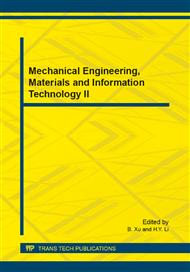[1]
S. Hauch and Y. Bai. Bending moment capacity of grooved corroded pipes. International Offshore and Polar Engineering Conference, ISOPE, Seattle, USA. (2000), p.253.
Google Scholar
[2]
S. H Ahn, K. W Nam and Y. S Yoo et al. Comparison of experimental and finite element analytical results for the strength and the deformation of pipes with local wall thinning subjected to bending moment. Nuclear Engineering and Design. Vol. 236 (2006).
DOI: 10.1016/j.nucengdes.2005.07.010
Google Scholar
[3]
L. H Han and S. Y He. Limit moment of local wall thinning in pipe under bending. International Journal of Pressure Vessels and Piping. Vol. 76 (1999), p.539.
DOI: 10.1016/s0308-0161(99)00031-9
Google Scholar
[4]
K. Miyazaki, S. Kanno and M. Ishiwata et al. Fracture behavior of carbon steel pipe with local wall thinning subjected to bending load. Nuclear Engineering and Design. Vol. 191 (1999), p.195.
DOI: 10.1016/s0029-5493(99)00141-7
Google Scholar
[5]
K. Miyazaki, S. Kanno and M. Ishiwata et al. Fracture and general yield for carbon steel pipes with local wall thinning. Nuclear Engineering and Design. Vol. 211 (2002), p.61.
DOI: 10.1016/s0029-5493(01)00438-1
Google Scholar
[6]
K. Miyazaki, A. Nebu and M. Ishiwata et al. Fracture strength and behavior of carbon steel pipes with local thinning subjected to cyclic bending load. Nuclear Engineering and Design. Vol. 214 (2002), p.127.
DOI: 10.1016/s0029-5493(02)00021-3
Google Scholar
[7]
D.J. Shim, J.B. Choi and Y.J. Kim. Failure strength assessment of pipes with local wall thinning under combined loading based on finite element analyses. Journal of Pressure Vessel Technology. Vol. 126 (2004), p.179.
DOI: 10.1115/1.1687382
Google Scholar
[8]
M. Zheng, J.H. Luo. Modified expression for estimation the limit bending moment of local corroded pipeline. International Journal of Pressure Vessels and Piping. Vol. 81(2004), p.725.
DOI: 10.1016/j.ijpvp.2004.05.005
Google Scholar
[9]
Y. Bai and S.R. Hauch. Analytical collapse capacity of corroded pipes. International Offshore and Polar Engineering Conference, ISOPE, Colorado, USA. (1998), p.182.
Google Scholar
[10]
S. Hauch and Y. Bai. Bending moment capacity of grooved corroded pipes. International Offshore and polar Engineering Conference, ISOPE, Seattle, USA. (2000), p.253.
Google Scholar
[11]
K. Hasegawa, K. Sakata and K. Miyazaki et al. Fatigue strength for pipes with allowable flaws and design fatigue curve. International Journal of Pressure Vessels and Piping. Vol. 79 (2002), p.37.
DOI: 10.1016/s0308-0161(01)00129-6
Google Scholar
[12]
S.H. Ahn, K.W. Nam and Y.S. Yooet al. Fracture behavior of straight pipe and elbow with local wall thinning. Nuclear Engineering and Design. Vol. 211 (2002), p.91.
DOI: 10.1016/s0029-5493(01)00447-2
Google Scholar
[13]
J.W. Kim and C.Y. Park. Effect of length of thinning area on the failure behavior of carbon steel pipe containing a defect of wall thinning. Nuclear Engineering and Design. Vol. 220 (2003), p.274.
DOI: 10.1016/s0029-5493(02)00386-2
Google Scholar
[14]
Y.J. Kim, D.J. Shim and Lim Het al. Reference stress based approach to predict failure strength of pipes with local wall thinning under single loading. Journal of Pressure Vessel Technology. Vol. 126 (2004), p.194.
DOI: 10.1115/1.1687379
Google Scholar
[15]
D. J . Shim, Y.J. Kim and H. Lim. Reference stress based approach to predict failure strength of pipes with local wall thinning under combined loading. Journal of Pressure Vessel Technology. Vol. 127 ( 2005), p.77.
DOI: 10.1115/1.1849228
Google Scholar


